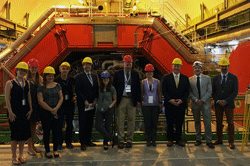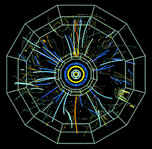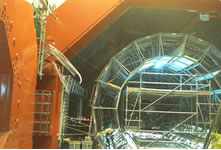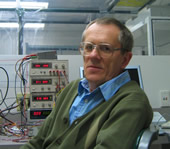




RHIG at Yale
Our research program focuses on understanding the strong interaction and the properties and evolution of the Quark-Gluon Plasma (QGP). We use the products of high momentum transfer, high Q2, scatterings, known as jets [1], and their substructure [2, 3] in proton-proton (pp), proton-nucleus (p-A), and nucleus-nucleus (A-A) collisions as a probe. In addition, our activities exploit event-by-event fluctuations and thermal fits to clarify the hadronic freeze-out conditions and their relation to the Quantum ChromoDynamics (QCD) phase transition. These studies are performed at STAR at the Relativistic Heavy Ion Collider (RHIC) at BNL, New York, and at ALICE at the Large Hadron Collider (LHC) at CERN, Switzerland. By comparing and contrasting results across the wide range of beam energies and species available from these two experiments, our investigations provide unique information on how initial conditions affect key features of the strongly coupled medium. This research is at the frontier of relativistic heavy ion physics.
The STAR experiment is one of the two large–scale experiments at the Relativistic Heavy Ion Collider (RHIC) at BNL, which began operation in 2000. STAR has multiple detectors, each specializing in detecting certain types of particles or characterizing their motion. At mid-rapidity these include a large volume Time Projection Chamber (TPC) for charged particle tracking and identification, a Time of Flight detector for enhanced discrimination of particle types at intermediate momentum, and an electromagnetic calorimeter to measure neutral particles and photons. In 2022, STAR was upgraded to enable unique measurements at forward rapidities. To date, STAR has collected data from pp, deuteron-Au, He3-Au, Cu+Cu, Cu+Au, Au+Au, U+U, O+O, Ru+Ru and Zr+Zr collisions at center-of-mass energies ranging from 3–200 GeV per nucleon pair in nucleus–nucleus collisions.
The ALICE experiment is the dedicated heavy-ion experiment at the LHC. It features precision tracking, particle identification, and electromagnetic calorimeter detectors similar in concept to those of STAR. In 2022, ALICE was upgraded to enable streaming readout of the TPC and enhanced precision vertexing of heavy-flavor particle decays. ALICE has collected pp, p-Pb, Pb-Pb, and Xe-Xe collision data at center-of-mass energies of 13.6, 8.16, 5.02, and 5.44 TeV, respectively, over an order of magnitude higher energies than those available to STAR. Pb-Pb collisions at the LHC result in a QGP that has an energy density, temperature, and lifetime significantly higher than that created at RHIC.
Both STAR and ALICE have large mid-rapidity acceptances, which enable simultaneous measurements of many observables to study signatures of a QGP phase transition and the space–time evolution of the collision. The goal is to obtain a fundamental understanding of the necessary conditions for QGP formation and investigate the properties and behavior of strongly interacting matter at high energy density. The Yale group has contributed significantly to many STAR and ALICE analyses and papers. Our recent focus has been on studies determining the underlying mechanisms of parton (quark and gluon) energy loss in the QGP and its response to this energy deposition. In addition, the Yale RHI group actively investigates the substructure of jets produced in pp and p-A collisions to further our understanding of the fundamental QCD process of fragmentation and hadronization, at both the perturbative and non-perturbative scale, and their relevant timescales. Our group also develops and applies new machine-learning techniques to improve our experimental measurements.
Finally, the Yale RHI Group continues to utilize its experience in detector R&D, design and testing. Recently, the group constructed and commissioned the inner readout chambers of the ALICE TPC Upgrade, completed in 2020 before the start of Run-3 of the LHC. Currently, the group is focused on designing detectors for the ePIC experiment at the future Electron-Ion Collider (EIC) and other R&D activities. These include hardware testing and design for the pfRICH and LFHCal detectors in ePIC and R&D for future gaseous tracking detectors utilizing GEM and [GridPix] technologies.
Jets
Jets are sprays of particles that form when high-virtuality quarks and gluons (partons) are produced in high-energy particle collisions. The partons then fragment to emit more partons, which can split into even more partons, resulting in a parton shower. Eventually, the partons confine into hadrons, a process known as hadronization. Jets serve as a proxy for the initial parton, which is not directly measurable. In heavy-ion collisions, jets can extract the properties of the QGP medium. The jets lose energy, and their complex structure is modified, a phenomenon called jet quenching.
References
[1] M. Connors, C. Nattrass, R. Reed, S. Salur, Review of Jet Measurements in Heavy Ion Collisions, RMP 90 (2018)
Jet substructure
Jets evolve from the parton shower, a perturbative QCD (pQCD) process, to hadronization, a non-perturbative QCD (npQCD) process. Thus, jets are multi-scale, complex objects containing information about these QCD processes. Jet substructure observables are carefully designed tools to reveal patterns in the jet structure to study QCD. The structure of a jet is also modified in the QGP medium.
References
[2] Quark-gluon Plasma Narrows Jets, CERN Courier (2021)
[3] Study Reveals How Some High-Energy Particle 'Jets' Lose Energy, BNL News Room (2022)